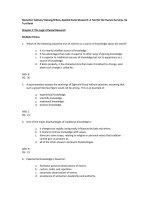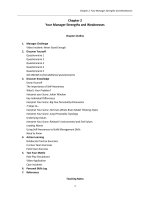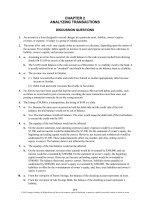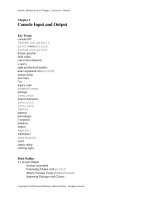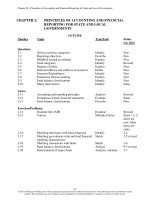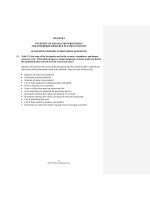Test bank and solution of applied social research a tool for the human services 9e (1)
Bạn đang xem bản rút gọn của tài liệu. Xem và tải ngay bản đầy đủ của tài liệu tại đây (609.61 KB, 4 trang )
Monette/ Sullivan/ DeJong/Hilton, Applied Social Research: A Tool for the Human Services, 9e
Instructor’s Manual
Chapter 2: The Logic of Social Research
Chapter Outline
Sources of Knowledge
Tradition
Experience
Common Sense
Journalism
Science
Scientific Practice
Theories in Research and Practice
What Is a Theory?
The Functions of Theories
Concepts and Hypotheses
Defining Concepts
Developing Hypotheses
Concepts and Operational Definitions among Minority Populations
Perspectives on Science
Deduction versus Induction
Types of Explanation
Paradigms in Science
Cause-and-Effect Relationships
Changes in the Ninth Edition
There are no significant content revisions from the previous edition.
Suggested Lecture Topics
1. SCIENCE VERSUS OTHER SOURCES OF KNOWLEDGE. Additional discussion of the differences
between science and the other sources of knowledge may be desirable. Emphasizing the
unique features of science and how they make science such a powerful source of reliable
information will assist students in developing an appreciation for what the scientific
approach can bring to practice and how it can reduce the pitfalls associated with the other
sources of knowledge. Although somewhat dated, the classic "The American Soldier--An
Expository Review," by Paul Lazarsfeld, pp. 378 380, Public Opinion Quarterly, 1949,
provides a good example of science versus common sense. It presents six quite logical
beliefs concerning soldiers and their behavior that research proved to be totally incorrect.
Another useful source is Neil Agnew and Sandra Pyke, The Science Game: An Introduction to
1
Research in the Social Sciences, 7th ed., Oxford University Press, 2007. This very readable
book presents the basics of science with a particular emphasis on the social sciences.
Tangible examples of the use of traditional knowledge can be found in a 2008 journal article
entitled “Analyzing Knowledge as Part of a Cultural Framework: the Case of Traditional
Ecological Knowledge” [(Mazzocchi, 2008 published in Environments 36 (2)]. This is an
interesting article because it presents traditional knowledge as a valuable source for models
of humans symbiotic and sustainable relationship with their natural environments. Another
interesting and very relevant article that may be a good resource in helping students
understand the value of practice knowledge is “Practice Wisdom: The Neglected Source of
Practice Research”. Published in Social Work (Scott, 1990), this article proposes ways in
which practice wisdom or rules of thumb may be tested by practitioners and researchers.
2. THEORIES IN SOCIAL RESEARCH. Given the amount of misunderstanding about theories and
their use in both research and practice, lecture coverage of this topic is warranted. Our
running example in this section is Sutherland's theory of differential association. This would
be a good choice for further discussion in lecture because it is set forth as nine quite
straightforward interrelated propositions that clearly illustrate our definition of theory. The
theory can be found in any edition of Sutherland and Cressey's Criminology textbook.
Another useful source is the classic, Social Theory and Social Structure, by Robert K. Merton,
New York, The Free Press, 1968. The two most useful essays are "On Sociological Theories
of the Middle Range" and "The Bearing of Sociological Theory on Empirical Research." For a
good presentation of the role of theory in applied research and practice , see Francis J.
Turner, Social Work Treatment, 4th ed., New York: The Free Press, 1996; and Paul Stepney
and Deirdre Ford eds., Social Work Models, Methods and Theories: A Framework for
Practice, Dorset, UK: Russell House Publishing Limited , 2001.
3. THEORIES IN SOCIAL WORK PRACTICE. Some human service practitioners view social theories as
largely academic and fail to see the roles they play in structuring the many services they
provide. Helping students to identify the ways in which theory impacts practice in various
practice settings will allow students to better understand the role of theory and the
relationship between theory, research and practice. A valuable resource for this discussion
is Social Work Treatment: Interlocking Theoretical Approaches (Edited by Francis Turner,
2011, Oxford University Press). This book begins with a chapter on the role of theory in
social work interventions. Subsequent chapters include presentations of the role of theory
in various areas of social work practice.
4. CONCEPTS, DEFINITIONS, AND HYPOTHESES. Because these are basic components of theory and
research, their initial introduction to students can benefit from discussion in lecture. Some
students have trouble with the difference between nominal and operational definitions,
particularly in developing operational definitions that reflect the nominal definition of the
concept in question. Additional discussion in lecture together with some practice exercises
is helpful in clarifying these definitions. The role of hypotheses in research is also
troublesome for some students. A common reaction is to question the need for stating
hypotheses prior to doing the research. Emphasizing how hypotheses are used as
predictions which can then be rigorously tested against the empirical data will help convince
the doubters as to the need for hypotheses. As Merton puts it so well, "Post factum
explanations remain at the level of plausibility rather than leading to compelling evidence"
(Robert K. Merton, Social Theory and Social Structure. New York: The Free Press, 1968,
2
p.147). One useful source is Thinking Methodologically, by Sheldon Goldberg and published
by HarperCollins, 1992.
5. THE CONCEPT OF CAUSE. Although we devote a considerable amount of space to this topic, it is
such a central issue in research that further elaboration in lecture may be desirable. A very
useful source of examples of the issues involved in establishing causal relationships using
real data is Travis Hirschi and Hanan Selvin, Delinquency Research: An Appraisal of Analytic
Methods, New York, The Free Press, 1967. Though focusing on delinquency, the book is
much broader in scope outlining virtually all of the issues surrounding the concept of cause.
Of particular value is their discussion of numerous false criteria of causation that have
cluttered the literature. For someone interested in a more sophisticated presentation of the
problems surrounding causal inference, a good source is the introductory chapter of Hubert
M. Blalock's Causal Inferences in Nonexperimental Research, Chapel Hill, The University of
North Carolina Press, 1964. A lighter and more humorous presentation on this issue could
begin by playing a YouTube video of a woman’s phone call to a radio station where she
complains about deer crossing signs in her area. She suggests these signs should be moved
to lower traffic areas to minimize accidents. Obviously she believes that these signs impact
the rates at which deer cross roads and may be responsible for her accidents. The video can
be found at: />6. A CRITICAL VIEW OF SCIENCE. Over the past few decades, much debate has occurred regarding
the logical-empiricist view of scientific activity. The basic argument is that actual scientific
work is not nearly as logical, rational, objective, or disinterested as the logical-empiricist
philosophy suggests. Rather, scientific activity is influenced by many non-logical, nonrational forces (gender and race, fads and fashions, struggles for fame and fortune, to name
a few). However, retrospective accounts of scientific work make it look like the logical
process often described in many research methods texts. This critical view can be difficult
to explain to students who are just learning the idealized version of what science is all
about, but we have introduced it in a few places in the text (for example, the discussion of
male and female “voices” in Chapter 4). The discussion can be introduced in association
with Chapter 1 and then explored in more depth with later chapters. Three sources for such
lecture material are Thomas Kuhn, The Structure of Scientific Revolutions, Chicago:
University of Chicago Press, 1962; Paul Feyerabend, Against Method: Outline of an
Anarchistic Theory of Knowledge, London: Verso, 1975; and Peter Galison and David Stump
(eds.), The Disunity of Science: Boundaries, Contexts, and Power, Stanford, Calif.: Stanford
University Press, 1996.
7. TO ERR IS HUMAN—THAT’S WHY WE NEED SCIENCE. The text presents the superiority of science
over other sources of knowledge, but another approach to convincing students of the need
for a scientific approach is to present a lecture on how casual human observation is prone to
err and how science protects against such error. There are many good sources on this topic,
but an entertaining one is the book by Thomas Gilovich, How We Know What Isn’t So: The
Fallibility of Human Reason in Everyday Life, The Free Press, 1991. Gilovich discusses such
topics as the misperception and misinterpretation of random data, how human motivation
and social determinants influence what we believe, and how science serves to challenge
dubious beliefs. Another more recent book that may be helpful is Reliability in Scientific
Research by J.R. Walker (2011, Cambridge University Press), especially Chapter 1, Section
3
1.3 (pp. 5-24),which presents several sources of human error in research and remedies for
addressing each.
Class Discussion Topics
1.
Supply the students with a list of several common concepts in the human services. Have them
locate nominal and operational definitions from the literature for each of the concepts. Are the
definitions for each concept the same? Are there alternative operational definitions for some of
the concepts? In those cases where there are alternatives, discuss them in terms of which seem
to be the best and why. Two issues of the journal Social Work are devoted to conceptual issues
in the human services: vol. 22, no. 5, 1977 and vol. 26, no. 1, 1981.
2.
The process of deduction comes into play at numerous points in conducting social research. At
some point, it is used to deduce operational definitions from nominal definitions, to deduce
hypotheses from theories, and to deduce conclusions from the data, to name a few examples.
Given the ubiquity of deduction in research, a valuable exercise can be created using syllogisms.
Syllogistic logic can be very similar to deduction in research. In fact, stripped of their elaborate
prose, theories can often be rewritten to take the form of syllogisms. For example, part of
Durkheim's theory of suicide can be rewritten as follows:
Premise 1: Social cohesion provides psychic support to group members subjected to acute
stresses and anxieties.
Premise 2: Suicide rates are functions of unrelieved anxieties and stresses to which persons are
subjected.
Premise 3: Catholics have greater social cohesion than Protestants.
Therefore: Lower suicide rates should be anticipated among Catholics than among Protestants.
Discussing syllogistic logic in class and providing the students with a series of syllogisms to
practice on can serve to enhance their deductive skills. It is also rather fun and the students
seem to enjoy it. Syllogisms are typically discussed in most any introductory logic text. Some
recommendations: Irving M. Copi and Carl Cohen, Introduction to Logic, 13th ed., Prentice Hall,
2008, and Peter A. Facione and Donald Scherer, Logic and Logical Thinking, New York, McGraw
Hill, 1978.
3.
Positivist versus non-positivist approaches to science is a complex topic, but students can begin
to appreciate the issues by comparing studies that have been conducted from each approach.
One way you might address positivist and non-positivist approaches with students in class is to
ask the class to help you outline a very basic research design on a simple topic with which they
are familiar. Students’ experiences transitioning from high school to college is one example.
Ask them what questions they would want to address and identify which will likely reflect a
positivist approach (e.g., What is the relationship between students’ high school grades and
their grades in the first semester at college) and which may will likely reflect a non-positivist
approach (e.g., How do students cope with the psychological stressors associated with the
transition to college?). Ask them to begin describing the types of data they may need to collect
to answer each question. This will help students begin to understand the nature and value of
both quantitative and qualitative research, which will be covered in more detail later in the
textbook.
4
